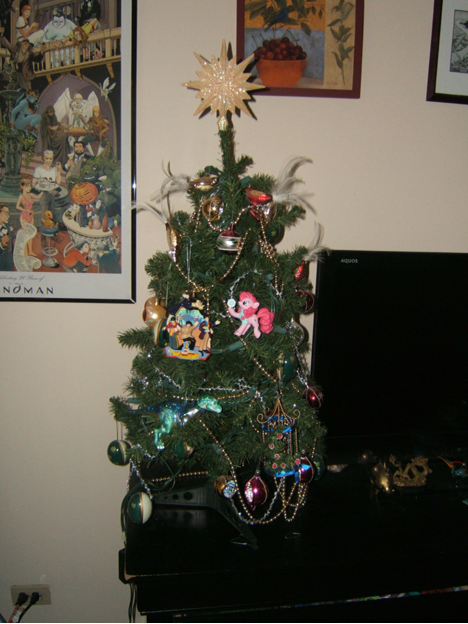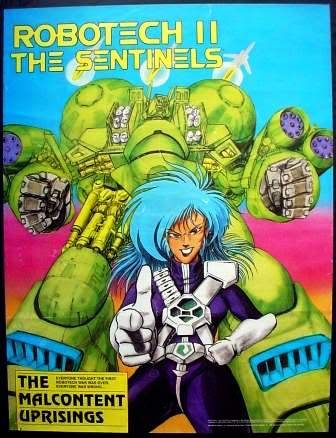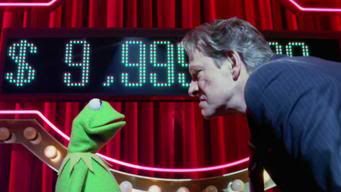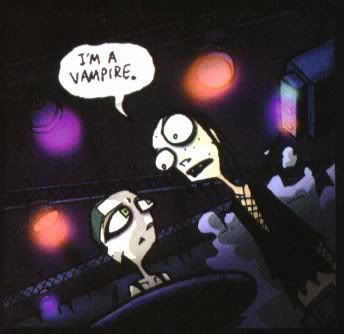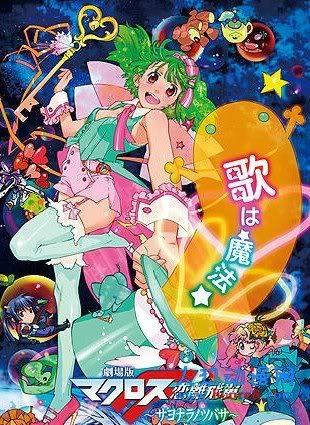
I cut this discussion from my original
Reflections on Macrophilia essay, because that essay's main focus was why I was drawn to the Zentradi of
Super Dimension Fortress Macross, and the opinions I developed in relation to that. Compared to this, any other Zentradi are an afterthought. However, on thinking it over, better explaining why I don't find the newer Zentradi characters to be all that appealing is a potentially interesting topic, and one I'd like to get off my chest.
Whenever I consider the issue, it is always first as a Macross issue. Robotech did indeed create new Zentradi and part-Zentradi characters, who will come under discussion shortly, but as Macross created the Zentradi, my reaction to their portrayal in that universe is the strongest and deserves the deeper consideration, not only because of perceived "authenticity" but because I had higher expectations for Macross' portrayals.
As I've stated before, I don't have any very strong attachment to any Zentradi character introduced after the original
Super Dimensional Fortress Macross. I used to consider this a sign of my being unable to see past my love for the first series to be truly open-minded about any successors to it, but eventually decided to presume my own clarity.
When it comes to the Zentradi, I feel like something has "gotten into" their portrayal, a certain I-don't-know-what. To oversimplify, it seems that Zentradi are squeezed into a set of narrow archetypes which are rarely deviated from, and that these archetypes are often weak derivatives of the original SDFM Zentradi. Furthermore, they are usually comic relief, fanservice, or plot devices instead of major characters, and never seem to get much compelling characterization. They just don't seem to pack the same impact as the original characters, even once you make allowance for the fact that these new Zentradi don't have a race-wide character arc.
The main exception is that a female Zentradi may be picked out of the pack and treated with more weight and sympathy than most others. I usually don't find these characters compelling, either, but this kind of thing makes it seem that female Zentradi have somehow become more significant, while the full-Zentradi male characters get the worst end. Peace children of both genders also tend to fare better. I know I preferred the original Zentradi male characters, but the real ideal is to have parity among the Zentradi genders when it comes to quality of characterization. Alas.
There are indeed some Zentradi characters I do like, but they are tertiary characters, and thus my attachments are never so strong. There is a certain level of depth/development a character must have for me to get a strong attachment to them, and none of those newer characters have it.
With that:
Guld Goa Bowman
I know viewers are supposed to feel sympathy for Guld, but I just can't like him. Guld is
volatile, creepy, and abrasive, off-putting far before the secret of his past is revealed. Sometimes harsh characters can be entertaining, but Guld is only grating. I don't believe he raped Myung, but what he did was bad enough.
All that would be enough to dislike his character. But he's also used as to demonstrate that Zentradi can be difficult and unmanageable. Obviously there have been internal problems with the Zentradi before, and no freedom is gained without a price...I like that Macross can show that. But to attribute any issues with Zentradi to a wide-scale racial corruption is too destructive a notion, too contradictory to the nature of Macross.
Why blame Guld's activities on Zentradi heritage, when humans have done similar things in real life? I don't feel sympathy for Guld because he "just can′t help it", because everyone has a reason for what they do, and it's impossible to justify an action simply on the grounds that a character had a "reason".
However, when looked at in light of other "peace children" characters, Guld also seems to be cut from a wholly different cloth. Not only is his appearance more overtly "alien" than the others, but he is the only one whose heritage gets any negative press or really any large narrative relevance.
Because of this, one could say that Guld was simply a bad seed among the peace children, about as definitive a representation as a bipolar or a schizophrenic would be of human nature. This is the explanation I prefer, rather than treating Guld as a representative sample. In that vein, his alien features are also unusual.
Out-of-universe, Guld is likely so different from the other peace children characters because
Macross Plus didn't start as a Macross production, and so Guld's heritage was chosen arbitrarily. Even if this wasn't the case, it'd be very hard to believe Guld's actions were intended to make a dark statement about Zentradi/human relations, however.
Still, even when coming up with a more palatable interpretation of Guld, I don't like him anyway. It's not that Guld is a flawed character, either. I love many other flawed characters, but Guld's presentation of such just doesn't interest me. He is apparently flawed because he is half-Zentradi, and not because he is Guld Goa Bowman, and this further pushes me away from him.
With there finally being benign male peace children, I at least can′t attribute Guld's portrayal to double gender standards anymore, though at the same time, I doubt a female Zentradi with similar problems or facial features would ever appear.
Veffidas Feaze
I am often tired of female Zentradi and peace children being either the sexy pilot or the cute young girl—these aren't bad types, just overused. Veffidas is very different, and for that I like her, although not as much as I want to.
You see Veffidas, though appealing, strikes me as less a character than a prop. The stoic, near-silent cast member who may occasionally speak wisdom is a valid character type, yet Veffidas takes it too far. Her few words are needless statements of the obvious rather than profound insights, and beyond that, one doesn't get a sense of real personality from her.
She is obviously a driven person, if she's drumming (or in the case of her past, brawling) morning, noon, and night, but it's taken to the point of silliness when she can′t stop it for anything and offers very little individual reaction to what's going on around her, simply drumming away in the background unless she's forced to stop. It makes her look mechanical rather than determined, empty rather than stoic, lifeless rather than quiet.
I can see how this might add up to a full characterization in the minds of writers and viewers, but to me it just doesn't. Even if Veffidas does get some backstory in some supplemental animated shorts, it has no impact on her in the television series, and therefore can't counteract the blandness of her longer appearances. It's a sad story, but only a fleeting moment of anything deeper for Veffidas.
Does Veffidas, then, fit my assertion that female Zentradi are given larger roles, post-SDFM? She does and she doesn't. On one hand, she doesn't seem like a full character to me, but on the other, she is prominent, and seems intended to be a full cast member equivalent to the rest of Fire Bomber, even if they all get better characterization than her. With Milia and Mylene to back her up, Veffidas is assuredly part of the trend, with all of them more active than Neo-Exsedol, the series' main male Zentradi character. In addition, the Protodevlin don't make her act like a nutbar, giving her the advantage over Neo-Exsedol.
It doesn't bother me, however, that Veffidas behaves the way that some might imagine a member of a stereotypical "warrior race" to act like: a soundless, unflappable creature that is committed to a single action. There's room in my worldview for Zentradi who are like that, just that it's not the majority of Zentradi, and that if it were, the race wouldn't be as interesting.
However, the way Veffidas is portrayed doesn't make her an effective example. She's just kind of...there. It's also laughable when Veffidas of the past acts as if she came from a fighting game--it just looks really cheesy. There are other elements of absurdity in Zentradi that work well, but those particular things just don't. I do like Veffidas, but at times it seems to be by a narrow margin. The type of character she represents can be appealing under the right circumstances, but here it just doesn't click.
Macross 5
Super-disappointed that a full-Zentradi fleet, a fascinating concept, is attacked and enslaved by the Protodevlin, instead of being explored in a different story. Thankfully many are rescued, but it's still wasteful in the sense that such a fleet could be used to tell a different kind of Macross story, and it ties in with the sense of Zentradi disposablity and irrelevance that I sometimes get from the material.
Commander Chloré
I have much nerdrage against Basara Nekki for being an obnoxious twit that gets the narrative to warp around him rather than actually growing and changing, but I can′t fault him for turning an entire fleet of female Zentradi to the side of humanity in an OVA. It's just a gender reversal of what Minmay did, only with the subtext made more explicit. It's short and not as awesome as SDFM's long version, but that's because it's just one OVA.
Certainly the way that fans interpret this image, with Basara as a "pimp" who manages to seduce all the female Zentradi at once because of his huge sexual prowess and no other reason, does bother me. However, this isn't the interpretation I get from the OVA itself.
Of course, that doesn't make Commander Chloré anything to write home about. She is pretty generic, the prickly female enemy who can easily be swayed by something nice. In serving as a catalyst for this genderswap of the original series she is effective, but other than that she's just not an interesting character.
Her character design, while it's a decently consistent extrapolation of the "Meltrandi" aesthetic from
Do You Remember Love? to commander uniforms, is just awfully ugly to me. The blazing pinks, greens, and blues, with the long cape and peaked shoulder harness, just make me think of a circus tent.
Advisor Tranquil
A rather silly-looking character, with huge mask/sunglasses/helmet covering her head, and the same circus-tent uniform as Chloré. She does not have a huge swollen brain like the male advisors in Neo-Macross, and so I find it harder to see the giant-brained advisor retcon as a neutral or even, to some, essential use of a sci-fi cliche. If it's just applied to the male characters, there's nothing neutral or essential about it.
Other than that, there's not much to say about her, because what little screen time Tranquil has makes her out to be the same kind of flat, submissive character as Laplamiz' unnamed advisor, as opposed to the reciprocal relationship between Britai and Exsedol.
The cherry on top is that Tranquil is another female Zentradi with an Engrish name, though it is only a fansub-derived Romanization and may have been intended to be something else. Still, I feel a little bit drawn to her because of the title "Zentradi advisor" having a positive link. Without her characterization, however, this is just a knee-jerk impulse and not actual interest.
Mylene Flare Jenius
Nothing really to say. I like Mylene in my own vague way, but her characterization doesn't really say anything about Zentradi portrayal, except she is another example of the tendency to throw in some Zentradi heritage for the main female characters, perhaps to give them an "exotic" touch. At least she is her own entity, rather than an extension of her parents.
Emilia Jenius
Can the ways that Emilia suggests similarity to Milia be justified by their parental connection? Actually, this time I'll let most of it slide because of that, except for the part where she's defeated by Basara and she then starts to come onto him. Jeez.
I'm still disturbed by the fethshization of giant female Zentradi or part-Zentradi. It's the weird sci-fi apex of the belief that women can never be threatening no matter the circumstances, not to mention making me feel like an involuntary voyeur when I see it. It's not that hard to believe that a giant woman can be a genuine physical threat or a neutral figure instead.
Ranka Lee
Ranka is cast in the Mylene mould: a cute girl with Zentradi blood which is barely mentioned except in small moments. Thus, she offers nothing to think about on those terms. As a character I find Ranka too saccharine and calculated, and was on Team Sheryl pretty much from the start. There's nothing particularly wrong with a Zentradi-blooded character having these traits, I just dislike them in general. She was more tolerable in the Frontier movies, though.
Brera Sterne
Cyborg or not, quarter-Zentradi or not, Brera at least levels the playing field when it comes to the portrayal of male peace children, and makes Guld easier to see as a neutral creation, and not the product of double standards or cynicism about the themes of SDFM. Also, "Quarter-Zentradi Bishounen Cyborg" just sounds awesome, even if Brera is pretty bland.
Elmo Kridanik
Characters who exist purely as comic relief are difficult for me to like, but I like Elmo Kridanik, to the point of not being very cynical about him at any point in time. This acceptance may be because he is a tertiary cast member and so easier to accept as what he is.
A Zentradi being a hyperactive talent agent who dresses like a preppy is also pretty awesome. The best evidence of the Zentradi becoming "real" after human contact is that they adopt jobs that would have been impossible for them before, and their descendents continue doing it. There is no badass Zentradi "image" to keep up, but instead the world is, in theory, entirely open to them.
I did wonder why Mr. Kridanik had a human name. It probably wasn't meant to state anything, but it's interesting to wonder what it
could mean. I did also wonder if he was related to Britai Kridanik, but I thought not, since it would have been said somewhere. It also seems too impossible for the hideous retconned Britai to have a child, too contradictory to the new image that has been created for him.
Klan Klang
I...do not like Klan Klang. She's a completely ludicrous character, and can't be saved by any attempts to give her poignant scenes after the fact. It's about what she is: a character who embodies several fanboy fetishes at once, but whom the plot then asks us to take seriously.
When reduced to human size, KIang essentially transforms into a child version of herself—a lower-than-expected height, cartoony eyebrows, huge eyes, and a more immature manner. The series tries to wring angst out of that position, but it's eclipsed by the very likely proposition that Klang was created for guilt-free f pedophilia, since she has several nude scenes and is still technically legal. Beyond that, at her natural size she's a huge-breasted giantess, whose gargantuan casual clothes look suspiciously like a schoolgirl uniform.
Instead of being an ostensibly neutral creation, Klang is therefore defined first of all by what she's designed to cater to, rather than who she is. When contemplating Klang's midget status, her fetishistic nature is the first thing that comes to mind, rather than her angst over that position. It doesn't feel like an organic part of her character, but something Klang is there
for.
Klang simply looks and acts so silly that observing her engaged in earnest, serious action can't compute. When she cannot save Michel, who might have loved her were he not concerned about looking sleazy, because she herself is helpless in a miclone chamber, it's supposed to be a tear-jerker, a poignant moment that ensures Klang transcends her pandering status. But it just can't be. It's simply impossible for me to take Klang seriously.
Nor can it be said that Klang was meant as an ironic take on the fanboy obsessions she is based on. Nothing about her circumstances suggest any subversion of conventions; her physical status is merely used to tug at the audience's heartstrings in a straightforward manner, and thus increase her attractiveness to viewers. It doesn't even inhibit her in battle in the end, as she's eventually shown piloting mecha in her tiny form.
Besides that, I just don't like Klan Klang's character design or name. Her "loli" outfit is a garish mish-mash of colours and layers, while her space suit has garter belts. Along with her floor-length blue pigtails and apparently size-changing eternal headband, somehow Klan Klang looks designed by someone with the worst stereotypes of "anime character" in mind. Her name, no matter how it's Romanized, doesn't sound like a Zentradi name at all, but a piece of Engrish. It somehow communicates the image of an anime character who is cutesy-poo and a little wild, but not to be taken seriously.
There is an irony here, since I have praised my favourite Zentradi characters for combining absurdity and genuine emotion to effective results. Yet when it comes to Klan Klang, I can't embrace her particular fusion of absurdity and seriousness. There's just too much wrongness all around.
Her being a gorgeous female Zentradi who pilots a red Queadluun-Rae also makes Klang seem like a Milia derivative, especially when you add Michel's equally superficial Max-like traits. Though Klang's personality is different, there are still so many possibilities for a character, so why go backwards?
I'll admit she looks pretty fucking awesome attacking Vajra with the FAST Packs, and seeing a Zentradi live a casual human life to that open extent is cute, but that's really it for me.
Klan Klangs' appearances in the
Macross Frontier films made her more tolerable and her bodily affliction seem more neutral, but only through reducing her role. I still can't like her, even then. Now she's just inoffensive, rather than interesting.
Michel Blanc
He's a tiny bit of a Max expy, with a cocky attitude, a blue mech, and glasses (in this case, actual glasses), but I like him a little. His "tragic" relationship with Klan Klang still can't make me bat an eye, though. His heritage manifests as no special traits, but again he is, thankfully, another benign male peace child.
Richard Bilra
Here is finally a Zentradi character with true gravitas, with highly individualized dreams and goals, the epitome of the freedom his race has gained. He is doubly notable as a male character with those traits, and one who lacks similarity to other characters. I don't even mind that he partly resembles the ugly male designs of DYRL, because he's an original character so there's nothing to ruin, and he looks more human than they did anyway. Also, he has an awesome life-sized train yard.
In short, Bilra is one thing I want to see more of with Zentradi characters. Characters with significance, desires, treated with at least some level of seriousness, who, in short, feel like they
matter, like they are vivid beings.
And yet, it was revealed that Bilra's entire grand dream, this desire for a galactic communications network, was only because he wanted to find Minmay. I still have difficulty articulating my objection without seeming as though Minmay isn't important to the Zentradi. She certainly is, and I could have accepted Bilra's search for Minmay to be a bonus that he intended to capitalize on while meeting a larger dream. But it's then clarified that finding the lost idol is his one and only motivation.
If it's all just for Minmay, it lessens Bilra's individuality, his distinction as his own character. Minmay can still be a legend, a partial motivation, but not the whole definition of his character. True freedom would not be defining oneself by one's heroes, but pursuing one's goals for their own sake.
As with Elmo Kridanik, I also wonder about his human name, whether it's to symbolize his new life, or he changed it for appearances. We'll likely never know, since such political concerns aren't Macross' prerogative, but it's interesting to speculate nonetheless.
The Shoppers of the Folmo Mall
Completely adorable. I about hit the roof when I saw the name of this thing, and it's wonderful visual. Sure, it's completely impractical and improbable to have giant Zentradi living normal human lives, but Macross has never been about physical realism, and if one can believe the Zentradi can exist without collapsing under their own weight, then being able to live like this is quite easy to accept.
Everybody from Galia 4
I'm really not happy with anything about "Fastest Delivery". I like the idea of Zentradi living in different tiers when it comes to relationships with humanity, but here it's just transplanting Zentradi who somehow act just like the original series into a modern setting, and then having them be passive and disposable.
In fiction, there will always be characters who just there to get the axe, but since this is the largest group of Zentradi with speaking roles that we have seen in a long time, it makes the treatment of these characters more disquieting than it would otherwise be. There's nothing really to counteract something like "Fastest Delivery" at all.
Just as in the original series, these male Zentradi are charmed by the arrival of a cute female pop star. Yet it feels out of place for them to act
exactly like the original series, since decades have passed in between, and these Zentradi are supposed to have dealt with humans before, to the point of wearing their emblems. Perhaps it only works if one believes that male Zentradi characters are inherently "otaku".
Major Ogotai's advisor apparently believes it, but it's far too limiting and silly a concept. If it is true, it means the male Zentradi were parodies first and characters second, held to different standards than the rest of the universe. That is obviously not true when you look at SDFM's portrayal of Zentradi fanboys, whose infatuation made sense in theme and context, and they were shown capable of loving real people and having sympathetic moments. Such a portrayal does not lead to the notion that male Zentradi are all goofy otakus no matter the situation.
One can look at the events of "Fastest Delivery" as not a fanboy infatuation, but the mere fact that it might get lonely out on this barren rock, and these Zentradi, who haven't seen a female in a while, might just get some normal stimulation out of even someone like Ranka. That could fly, but the fact that Major Ogotai calls attention to it as a specifically retro trait makes it hard for this interpretation to stick.
That the major Zentradi roles in "Fastest Delivery" all belong to apparent clones of earlier characters is also disquieting. In theory it is possible to run into clones of pre-established Zentradi characters, since they were all supposed to
be clones, but by not following this to the letter, by giving each significant Zentradi an individual appearance, they were made more distinct and sympathetic, and therefore improved the story of Macross.
Thus, it is difficult, emotionally and intellectually, to go backwards and now accept true clones as distinct characters. An explicit cloned Zentradi could become a likable character in the right hands, but it doesn't work out here, as these are all essentially disposable. I'm also really hoping Major Ogotai and his advisor's appearance wasn't intended to show that the high command of the male Zentradi fleets are all supposed to look exactly the same, either.
In addition to the empathic difficulties, it seems lazy to not create new character designs instead. Temujin is a particularly bad offender, since he is essentially the same character as Kamjin: same appearance, same personality, same actions, and all.
It's also harder to consider this issue neutrally when there aren't any clones of Milia running around, and put in this same disposable position. This group is entirely male, which does reinforce their archaic nature (before undoing that internally with the Queadluun-Rae thing), but the end result suggests that male Zentradi characters are somehow less favoured.
For example, compare this episode to "Fleet of the Strongest Women", which does have an all-female group of Zentradi falling suddenly for the actions of a star of the opposite sex, but these were "uncultured" Zentradi, making it easier to understand, and their ending was also positive. Furthermore, because that episode existed in a universe where female Zentradi get the better roles, I go easier on it.
Major Ogotai also comes off as a rather weak person who needs humanity to save his troops. I's not about ruining Britai's image, but about Zentradi in general needing to be rescued by humanity rather than working alongside them as equals in the future.
His advisor is so unimportant that he does not receive a name. Much of my complaints against Ogotai, and the related justifications, can be applied to him. And note his appearance suggests that Neo-Exsedol was not a physical modification, but has, in terms of the new Macross continuity, always looked like that.
The rebels are easier to accept in that it seems more plausible for latter-day Zentradi to go rogue than for them to act the same around humans that their ancestors did. However, the use of a pop star's appearance as their ultimatum is too silly, even if Temujin really intended to go and fight anyway.
However, their rebellion, as I mentioned, is presented with a thin explanation, which makes it seem just a device to set up the huge reference to the original series. However, I do get kick out of the rebels being attired in DYRL armour, even if it was likely not a slam against DYRL.
Finally, these Zentradi, saved and rescued in various ways, safe from danger...are destroyed in the next episode by the Dimension Eater. Yeah, it's a case of needing to show Shit Getting Real, or just Grace's own evil, and the Zentradi can be thought of in the same terms as horror movie victims: establishing just enough characterization so that the audience is shocked, but not hit so hard, when they bite the dust. Yet when none of the main characters react at all to the massacre that just occurred, and a similar thing already happened to the Macross 5, it falls flat.
Arguably this isn't really the point. These Zentradi act the way they do in order to facilitate a homage to the original series, going the extra mile by even having characters who look like the "original" Zentradi. Yet there's enough danger and peril in this story that it can be studied as an earnest representation of Zentradi, rather than the need for homage serving as justification for everything.
Other
Unfortunately, I'm not familiar with any other Macross-era Zentradi characters outside of these. I know of certain names from video games or
Macross the Ride, but I haven't seen any of these characters "in action", so to speak, and so cannot offer my opinion on their portrayals.
Conclusion
With the Zentradi's character arc from SDFM in the past, the greatest desire I would have is to see new Zentradi characters who "click" with me, in different ways than the original ones, but who possess the sense of being fuller and more significant characters than Elmo, Richard, and Veffidas.
I'd also like to resolve that weird gender disparity that, boiled down to its most simplified terms, is that full-blooded male Zentradi are for comic relief or distant command figures, while female Zentradi and both genders of peace children are presented in a much more well-rounded way--even if I don't like many of them, they're obviously intended to be sympathized with. This generalization gets more complicated when the characters are looked at individually, but it's an impression that's impossible to shake.
It's still possible that the Zentradi tropes shown here, when they are inevitably revisited, could at last become likeable to me. Even if they did, however, I would still wish that Zentradi characters had the same range of personality as the human ones. The archetypes of Macross human characters are repeated nearly as often as the Zentradi's are, but from an objective standpoint, that is still something to take issue with, just that I don't do so as much, because I have a certain sentimental attachment to the Zentradi. This is also the reason I'm interested in their portrayal, now that the character arc is over and my favourite Zentradi characters are gone.
